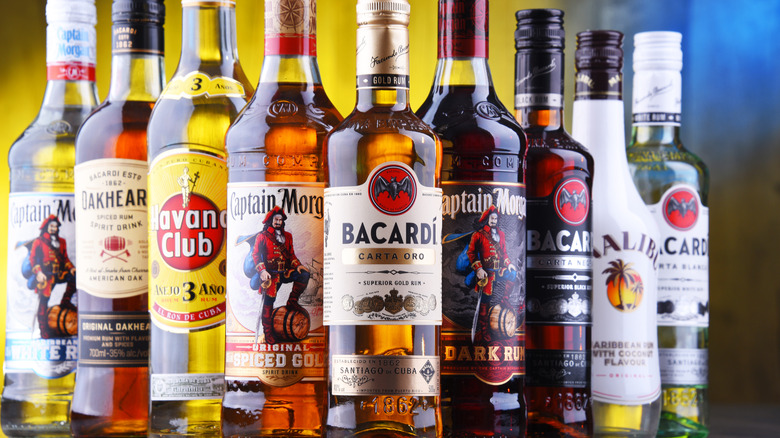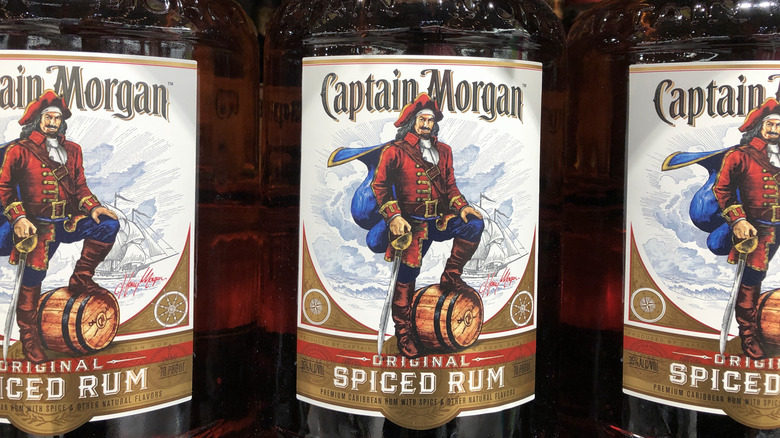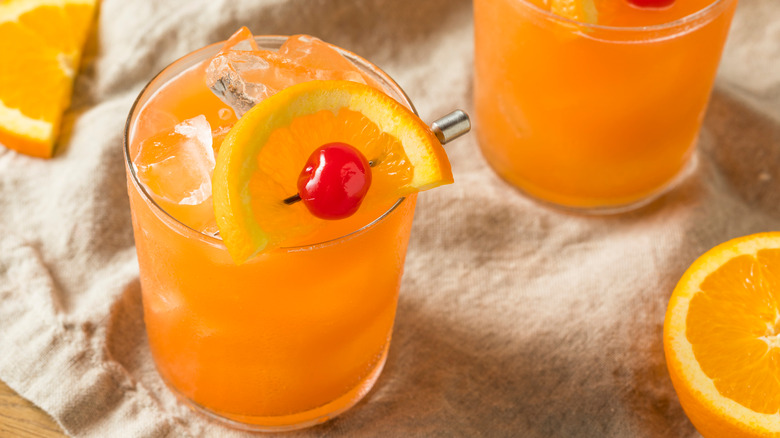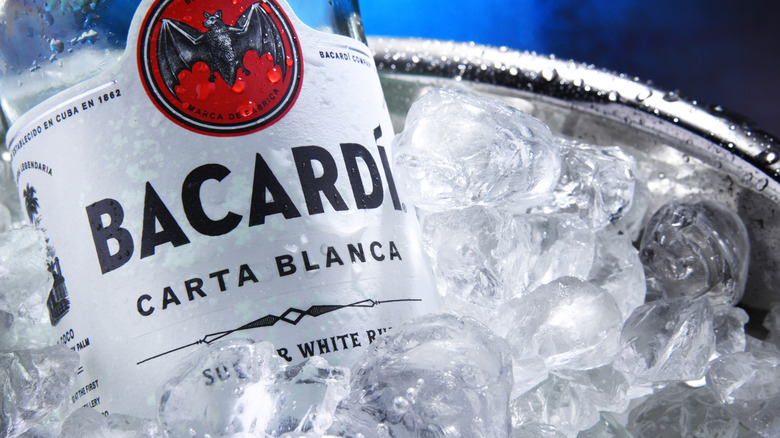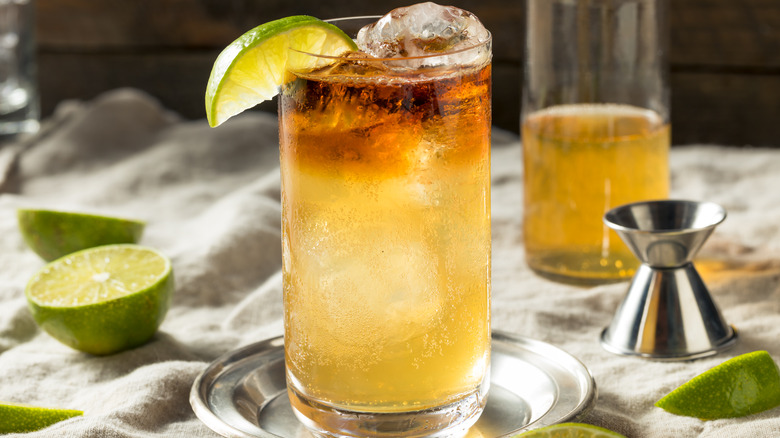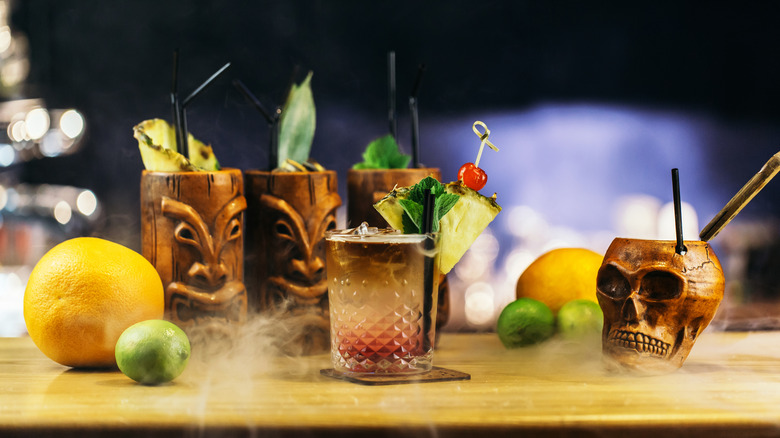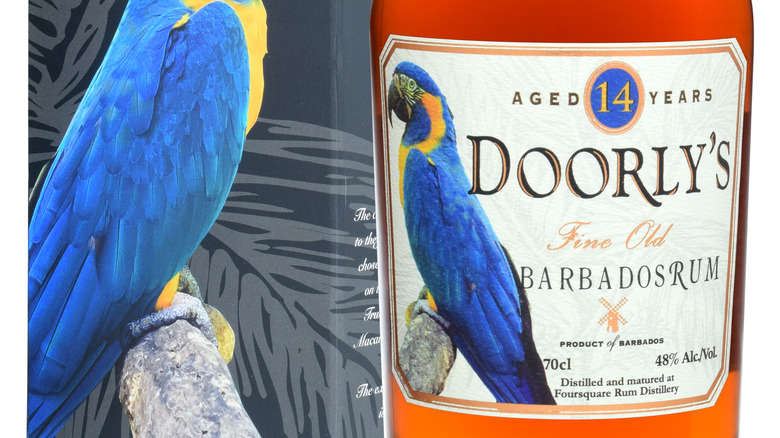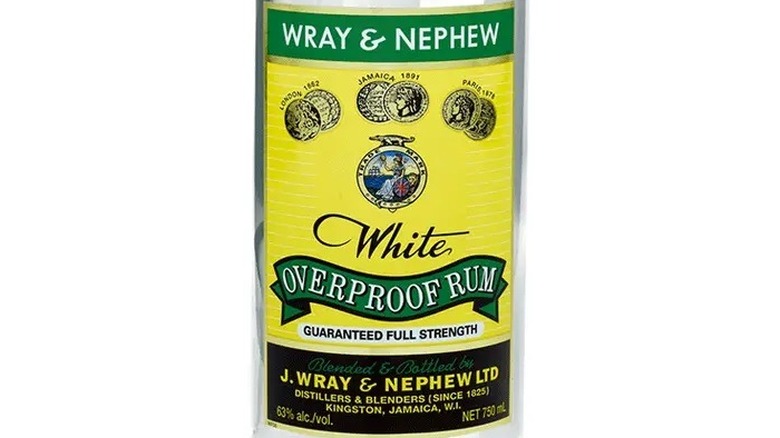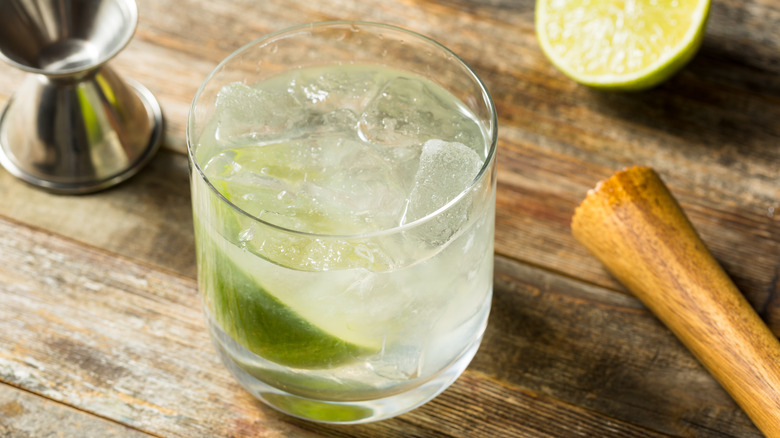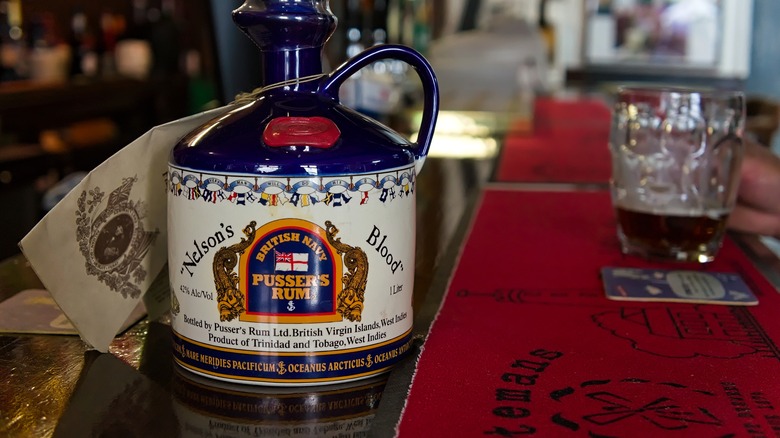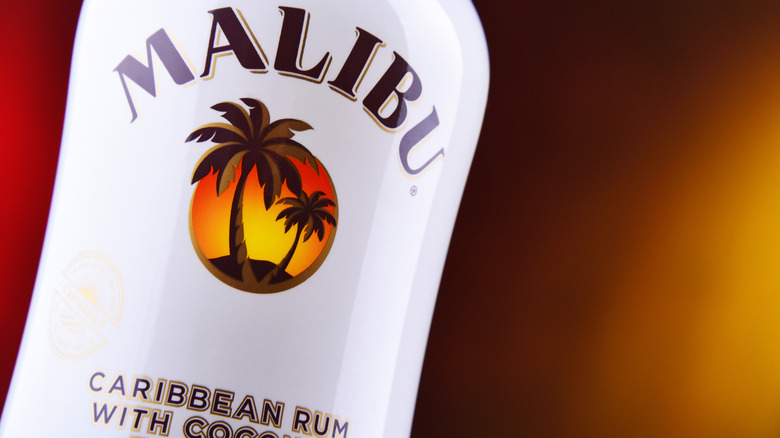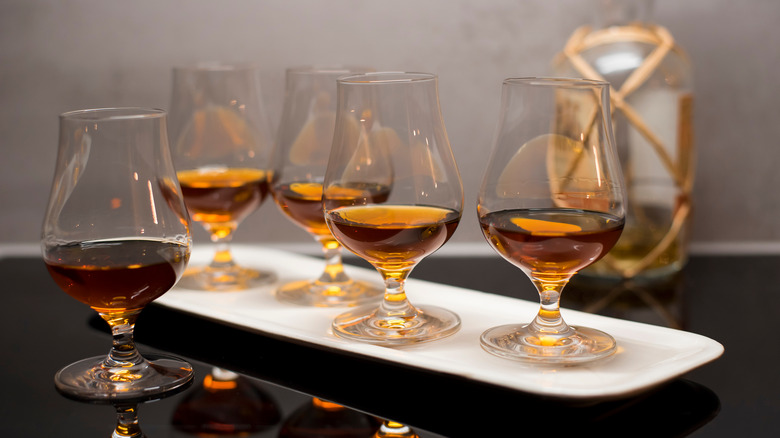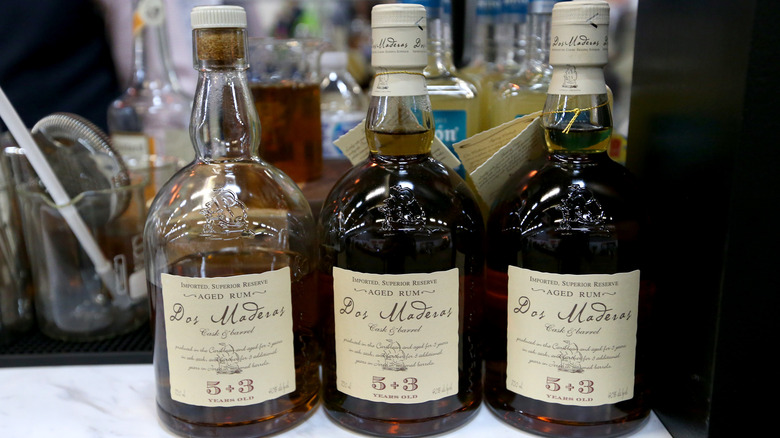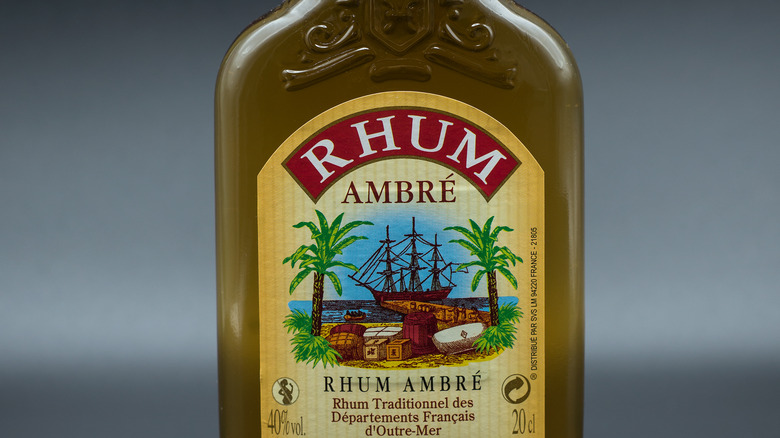13 Types Of Rum, Explained
We may receive a commission on purchases made from links.
Don't limit your impression of rum to daiquiris and Dark 'n' Stormies: This spirit, which offers a wide range of depth, deserves to be considered beyond just circa-1980s tiki bars and tropical getaways. While all rums are crafted from byproducts of sugarcane — traditional (or industrial) rums include molasses (which gives the category its tell-tale caramelized sweetness), earthy agricole (or agricultural) rums are made from sugarcane juice — that's about all the different variations share in common. Age, distillation method, and even place of origin all work in tandem to create different varieties of the spirit, each with a distinct use, profile, and history.
Some rums are made for mixing into cocktails, others are good enough to sip straight (but you can still add a paper umbrella for fun). Keep reading to learn the nuances of each type of rum on the market (while keeping in mind that some bottles fall into multiple categories) and, most importantly, how best to enjoy them. Bottoms up!
Spiced rum
Broadly speaking, this popular variation is defined as any rum that's infused with myriad herbs and spices. According to the Rum Lab, spiced rum came about as a way to make rum more palatable, since "fresh" rum packed a good amount of potency back in the day.
To make it, the process begins with distilled white rum, which then undergoes a maceration process with the chosen spices (as a gin would in order to become infused with botanicals) to build complexity and develop flavor. Early spiced rums were often flavored with sweet vanilla and citrusy lime (via Steve the Barman), but the ingredient range has since expanded: allspice, cinnamon, nutmeg and other warm flavors (sometimes even hints of dried fruit) have all become popular additions. Molasses is added after to develop rich color before the rum is aged in oak barrels.
You're probably most familiar with the Captain Morgan version, which brought national awareness to spiced rum when it was released in the U.S. in 1984. Since then, it's become a liquor shelf staple with several offerings from major rum brands and spiced specialists such as Kraken and Sailor Jerry. A shot of the spirit can add depth to a classic rum and coke, spruce up a Long Island Iced Tea, or create a winning two-ingredient tipple when paired with apple cider or pineapple juice.
Gold rum
Vanilla, coconut, citrus, and caramel are some of the tasting notes that you might find in a gold or amber rum, which hit the sweet spot between light and dark rums in terms of both aging time and taste. These medium-bodied rums get their color from added caramel or being aged in pale oak barrels and lean a touch sweeter to taste, with a subtle buttery richness that makes for a pleasant on-the-rocks sipping experience.
Gold rum is quite versatile and can easily take the place of a white rum in a cocktail where you're looking for a little more punch for your pour. Opt for gold rum in your go-to mojito cocktail recipe, a rum swizzle, or an Ace of Clubs daiquiri. And if your sweet tooth extends beyond cocktails, gold rum is the superior choice for baking — a splash in your cake batter, bread pudding, or bananas foster will offer much more toasty, oaky, brown sugar-rich complexity to your dessert.
White rum
If you like piña coladas, you probably like light rum (and maybe, getting caught in the rain). The most common type of rum out there, white rum (also known as silver or light rum) is light in body, sweet in flavor, and has a pleasantly mild character. While it's still made from sugarcane juice or molasses (as other rums are), white rum is typically only aged for about a year, which is a much shorter time span than that of dark rums, and therefore yields a less-bold taste. Most white rums are aged in stainless steel tanks to prevent any color pick up, or filtered through charcoal to remove any tinge of color (but maintain a slightly deeper flavor) if they're aged in plain oak casks.
Though generally not the boldest in flavor, white rum is like the little black dress of rums, in that it works seamlessly into any cocktail you can imagine: classic choices include any daiquiri and mojito or a piña colada.
Dark rum
Dark rum is exactly what it sounds like — rum that's deep brown in appearance. Be mindful, though, that not every dark rum's rich hue is indicative of more flavor. While most high-quality dark rums are aged for years in charred oak casks, taking on their deep toasted flavor in the process before they're filtered and bottled, others are simply shaded with a heavy hit of molasses or caramel coloring. So make sure you can tell which is which before you buy your bottle.
A well-aged dark rum boasts hints of brown sugar, toffee, and sometimes vanilla and honey, which lend well to enjoying the spirit straight to let each layer of flavor shine. (A fizzy topper of tonic water also does wonders to open up the spirit.) You can't go wrong with a splash in craft cocktails, either. The heavier body will add a pleasant viscosity. You'll find them in stalwarts like a Dark 'N' Stormy, Hurricane, or Painkiller.
Black rum
Black rum can be a bit of a wildcard when it comes to what an imbiber can expect upon opening the bottle. One would think that the spirit's ultra-dark hue would mean that it's aged for decades, meaning you're getting the most full-bodied flavor from your pour, but black rums can be shaded with the caramel color of molasses to mimic the appearance of spending years in barrels (it sees very little, if any, aging otherwise).
First popularized in the post-Prohibition era as a cocktail mixer (the idea was to make it the base of a punch), black rum was meant to mimic the look of a deeply aged rum at a lower price point, according to Martin Cate, author of "Smuggler's Cove: Exotic Cocktails, Rum and the Cult of Tiki" (via Liquor.com). Its production leaned into the assumption from uninformed imbibers that a darker, more opaque spirit equates to more flavor and better quality. That's not to say that there aren't some quality expressions of black rums out there. Gosling's Black Seal is produced in Bermuda and combines both pot-stilled and continuous-stilled spirits. The spirit is aged for three years in white oak and crafted with fermented molasses, so it offers much more body and interest.
Black rum blends seamlessly into a variety of rum cocktails with its molasses-forward flavor. It pairs particularly well with bright citrus and works well as a finishing element for tiki drinks vs. any cocktail where booze is the star.
Aged rum
Aged rums get their warm, toasty hue from sitting in barrels for extended periods of time. Despite the labor in making this style of rum, it's grown quite popular in recent years, taking its cues from the careful, regionally tied distillation methods of Scotch and whiskey, resulting in a nuanced, quaffable spirit. Of course, these rums are relatively rare by nature since they take so long to come to fruition. Plus, there is also a good deal of rum lost to evaporation from each barrel as it continues to age (this vanishing portion is called the angel's share), so there's even less to go around.
Every aged rum is a little different, but you can count on more character and nuance the higher the age statement on the bottle is. Aged rums are ideal for sipping neat or on the rocks — you really don't need any bells and whistles here — but also make a great sub for bourbon in cocktails given its caramel-y richness.
Overproof rum
Lightweights beware: Overproof rum, which is any rum that contains more than is over 57.15% ABV, packs a wallop. Like its close cousin, navy rum, overproof rum also made appearances on British navy ships, since the lack of water in the rum wouldn't ruin gunpowder's ability to light (like regular proof rum would) if the spirit spilled (via Flaviar). The test to determine what rum qualified as "overproof" developed as follows: a small bit of rum was blended with gunpowder. If it produced a flame when ignited, there was "proof" of alcohol and if it exploded like a cannon, it was categorized as "overproof." Later on, these findings came to form the definition of 100 English proof (57.15% ABV).
Considering its high potency, we wouldn't recommend taking shots of Bacardi 151 and its ilk, but it's a good bet for drink floats and tropical tipples. And if you're looking to (safely, please) whip up an eye-catching flaming cocktail and desserts like a baked Alaska, overproof rum is your go-to for that flambé wow factor.
Rhum agricole
The primary difference between rhum agricole and typical rums (besides the funky French spelling) is that rums done agricole-style are distilled directly from pressed cane sugar instead of fermented juice or cane byproducts. To make it, the cane is cut up and crushed; then the juice is set to ferment before going to column stills. The process got its start in Martinique in the mid-19th century when the island's sugar industry was being undercut by cheaper sweetener alternatives, so producers got creative and found methods to use every part of the sugarcane (via Bloomberg).
Nowadays, rhum agricole is crafted in French-speaking Caribbean territories like the French West Indies, Guadeloupe, and Marie-Galante, but it will always remain an integral part of Martinique's culture. With a name meaning "agriculture" in French, it's no wonder this rum has a grassy, vegetal tinge to it — you can smell the terroir the second you pop open a bottle. Though rhum agricole can be a touch difficult to mix and play with in cocktails, given its unique flavor profile, the traditional Martiniquan way to enjoy the spirit is in Ti' Punch (an abbreviation of "petit punch") which consists of a few shavings of lime peel, a blob of cane syrup, and a couple of ice cubes.
Navy rum
We all know that rum is the spirit of choice for pirates, but it turns out that the British navy had a strong taste for the stuff as well, enough to have its own eponymous style. Navy rum is a blended, aged rum that typically includes varieties from multiple different rum-making colonies in one single bottle. It's called "navy" as a reference to the rums that were found on early British navy ships — a blend of spirits from different ports visited across the Caribbean and parts of South America. Each one of the colonies produced rum and sailors would consistently grab casks to bring with them, so you can imagine how different each ship's selection was depending on where it docked.
When it became essential to supply rum to all navy ships, the British navy teamed up with James Man in 1784 to provide the spirit to each fleet, creating a consistent product with a blend of different rums. Official navy rum ceased production in 1970 (via Robb Report), but if you have the research time (and the hefty budget) you can snag a true bottle of navy rum today. And if you don't mind forgoing a vintage bottle, Pusser's offers a great option that will satisfy your sailor's heart.
Flavored rum
Flavored rum is, quite simply, any rum with flavoring agents added that aren't natural spices or the infusions you might find in spiced rums. These rums begin with a neutral, sweet base of rum before the flavorings and colorings are added. This is a pretty broad category with options ranging from simple tropical infusions (think pineapple and coconut) to more involved flavor profiles like coffee, chocolate, and cherry vanilla. Captain Morgan even produces a seasonal pumpkin spice rum shot.
Among the most popular flavored rums on the market is Malibu, which is highlighted by notes of coconut. Funky hybrid spirits like Rumchata, a cream liqueur that fuses rum with the flavors of the popular Latin American rice-based drink horchata, are also close cousins of this category. It's probably best to keep these bottles relegated to themed cocktails with plenty of other add-ins to create some depth. You'd be hard-pressed to find any self-respecting cocktail aficionado sipping this stuff straight.
English style rum
These molasses-based rums are made using traditional techniques — typically pot-still distillation (though some modern iterations make use of the column still) — in British colonies like Barbados, Guyana, St. Lucia, and Jamaica, and are considered the earliest iteration of the colonial rums (before the French and Spanish colonies). These colonies came on the rum scene far before their French and Spanish counterparts and were responsible for pioneering many traditional craft techniques. And since they were so successful in doing so, they stuck to their tried-and-true production methods of pot distillation for decades — column distilled rums were looked down upon until the technology started taking off in the late 1800s (via Cocktail Wonk).
Modern-day British rums are characterized by the distilling method (now made using a mix of pot and column distilling) as well as a wild yeast-fermented molasses base rather than cane juice. These sweet, rich expressions are great on the rocks.
Spanish style rum (Ron)
When Caribbean rum production was starting to take off, Spain prohibited any of its colonies to join in on making any distilled spirits until 1796. These rums are made in former Spanish colonies such as Cuba, Puerto Rico, and the Dominican Republic, with Baracrdi topping the charts as the most recognizable Spanish rum brand today. The signature differentiators of Spanish-style rum are its column distilling method and the charcoal filtering process it undergoes during aging, which was pioneered by Bacardi to make the spirit lighter and less potent on the palate.
Another Spanish rum production method borrowed from sherry and brandy is the solera barrel aging system. A stack of barrels (also called a criadera) is set up and new, unaged spirits go into the top barrels, while the finished rum is pulled from the lower barrels, which contain rum that's trickled down from the top. All in all, this system ensures the rum reaches a stage of complex, full maturity before it's bottled (via Dos Maderas). These rums are soft and approachable since most of the flavor comes from the barrels the spirit is aged in vs. from the distillation process itself.
French style rum (Rhum)
French style rhum is perhaps the most consistent tasting out of the three colonial styles of rum, since it must adhere to strict production techniques and standards such as distillation length. In the mid-19th century, France was invested in the rum-producing capabilities of its territories, so single-column stills came to the islands like Martinique, Guadeloupe, and Reunion Island quite quickly. These stills had to be tweaked to accommodate the nuances of working with sugar cane juice and ultimately became known as the Creole column still, according to Cocktail Wonk.
Rhums, which hail from the French Caribbean, are all produced in column stills using sugar cane juice fermented for up to five days. The resulting flavor is softly sweet, with fresh grassy undertones and elegant hints of floral notes. Rhum agricole is considered a French rhum, but is subject to slightly more specificity than the general category. Today's notable rhum producers include Rhum JM and Rhum Clément and they can be enjoyed straight or on the rocks to appreciate the spirit's unique flavor properties, or blended into a delicate punch with a touch of citrus and sweetener to let its natural taste shine through.
